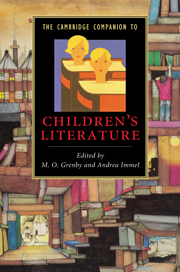Book contents
15 - Animal and object stories
from Part III - Forms and Themes
Published online by Cambridge University Press: 28 November 2010
Summary
The association of animal and child in children's books is so common that it is easy to forget the figurative nature of this alliance - the way we have penned the animals in - whether it be Kermit the Frog, Rupert Bear, Bugs Bunny, the Cat in the Hat, Peter Rabbit or Toad of Toad Hall. In this chapter I want to explore this relationship, showing how it has been used in children's literature both to support the dominant order, and also to subvert it. There are wider issues to explore too, for the word 'animal' has its etymological roots in 'breath' and 'soul', which link it to that which is 'animate', and this is exactly the transformation that writers and illustrators so readily perform, making animals live in all manner of anthropomorphic ways. And not only animals, for other 'things' are just as easily animated: from puppets and dolls (Pinocchio, Winnie-the-Pooh, Woody in Toy Story) to more everyday objects such as coins, peg-tops and looking-glasses.
So, first of all, we need to ask why there is such a close association between animals and children in narratives for children. Perry Nodelman suggests that, in terms of 'humanized animals', the association happened 'more or less by accident', in so far as Aesop's fables provided a suitable early example of didactic literature for children, which was then emulated by others. Karín Lesnik-Oberstein, on the other hand, sees the key association being forged by the Romantics, where the child is linked to nature, existing outside culture and language in some Edenic space.
- Type
- Chapter
- Information
- The Cambridge Companion to Children's Literature , pp. 242 - 257Publisher: Cambridge University PressPrint publication year: 2009
- 6
- Cited by

